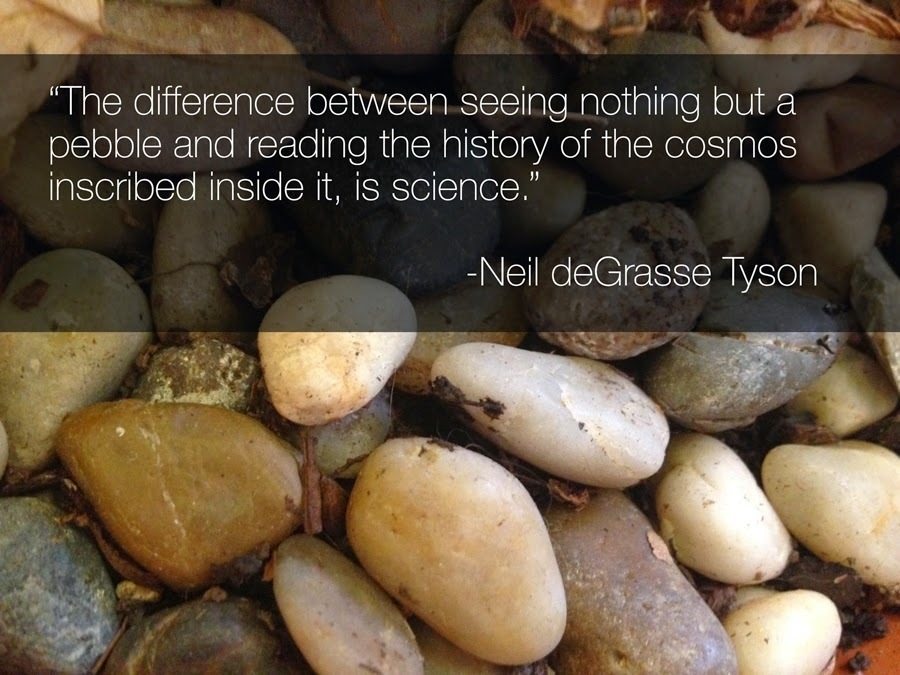Cosmos
- The app included on every iOS device and a great way to enjoy a variety of subjects with your morning coffee! ↩︎
The length of a human life is around 80 years. You might get 100 if you’re lucky. The universe is about 13.7 billion years old. The vast difference between a human lifespan and the age of the universe can be difficult to grasp — even the words we use in attempting to describe it (like “vast”) are comically insufficient.
To help us visualize what a difference of eight orders of magnitude might look like, Wylie Overstreet and Alex Gorosh have created a scale model of time in the Mojave Desert, from the Big Bang to the present day.
Working through my blog archive to simplify categories and came across this post from almost 10 years ago. There’s nothing quite like a long night under the stars. Weeping to the Cosmos // Beardy Star Stuff
What is Earth Made of
One aspect of astronomy that I have grown to love and appreciate is the tie in to the other areas of science. For example, planetary geology which, in turn, ties into our study of our own Earth’s geology. Of course this also ties into chemistry. And biology. And on on and.
This morning as I browsed Apple News1 I came across this very nice introduction to the geology of our planet. A quick read that might lead you to a much deeper exploration.
So, for example, this little bit about the Earth’s crust:
Earth's crust is made up of several elements: oxygen, 46.6 percent by weight; silicon, 27.7 percent; aluminum, 8.1 percent; iron, 5 percent; calcium, 3.6 percent; sodium, 2.8 percent, potassium, 2.6 percent, and magnesium, 2.1 percent.
I always enjoy sharing with folks that particular tidbit about the crust being almost half oxygen. I think we generally think of oxygen as an important part of the air we breath and forget that it’s not just a gas. It’s fun to remind people that it also exists as a primary element in the oxide compounds of the ground we walk on!
Story of a sunset
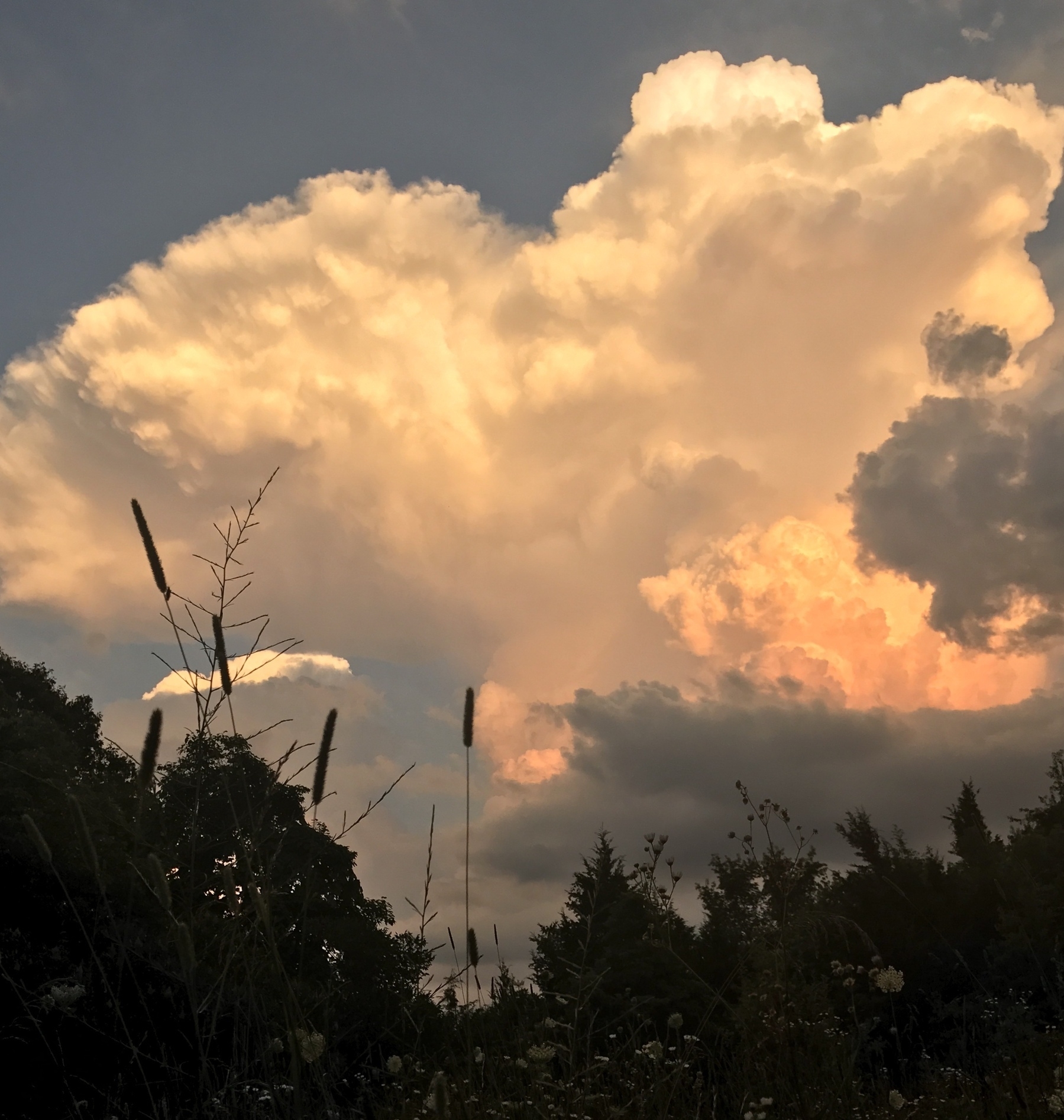
As the sun begins to set the world around me begins to dance.
As my feet crunch along the rock road below, dragonflies spin through the air just above my head. There are so many of them feeding in the fading light of the day that they form a small swarm. Higher in the air the night hawks perform their own acrobatic maneuvers above the fields, also in search of an evening meal.
Nearby, whitetail deer run across the road just as a light breeze finds this smiling human on a quiet rock road. The movement of air brings a mix of sensations to my skin and a sweet scent to my nose.
In the background of it all a sunlit cloud arrangement, complex in its movement, an ongoing description of the forces creating it.
The earth’s rotation pulls the sun further down.
Earth — Shot on iPhone with Carl Sagan narration
Carl Sagan’s Pale Blue Dot is fantastic and this is a good use of it.
Downhill
There was a moment in the early years of the universe when all of spacetime was a plasma. Particles and light had not yet gone their own way. Then they split.
It’s been downhill ever since.
Finishing the Herschel I program
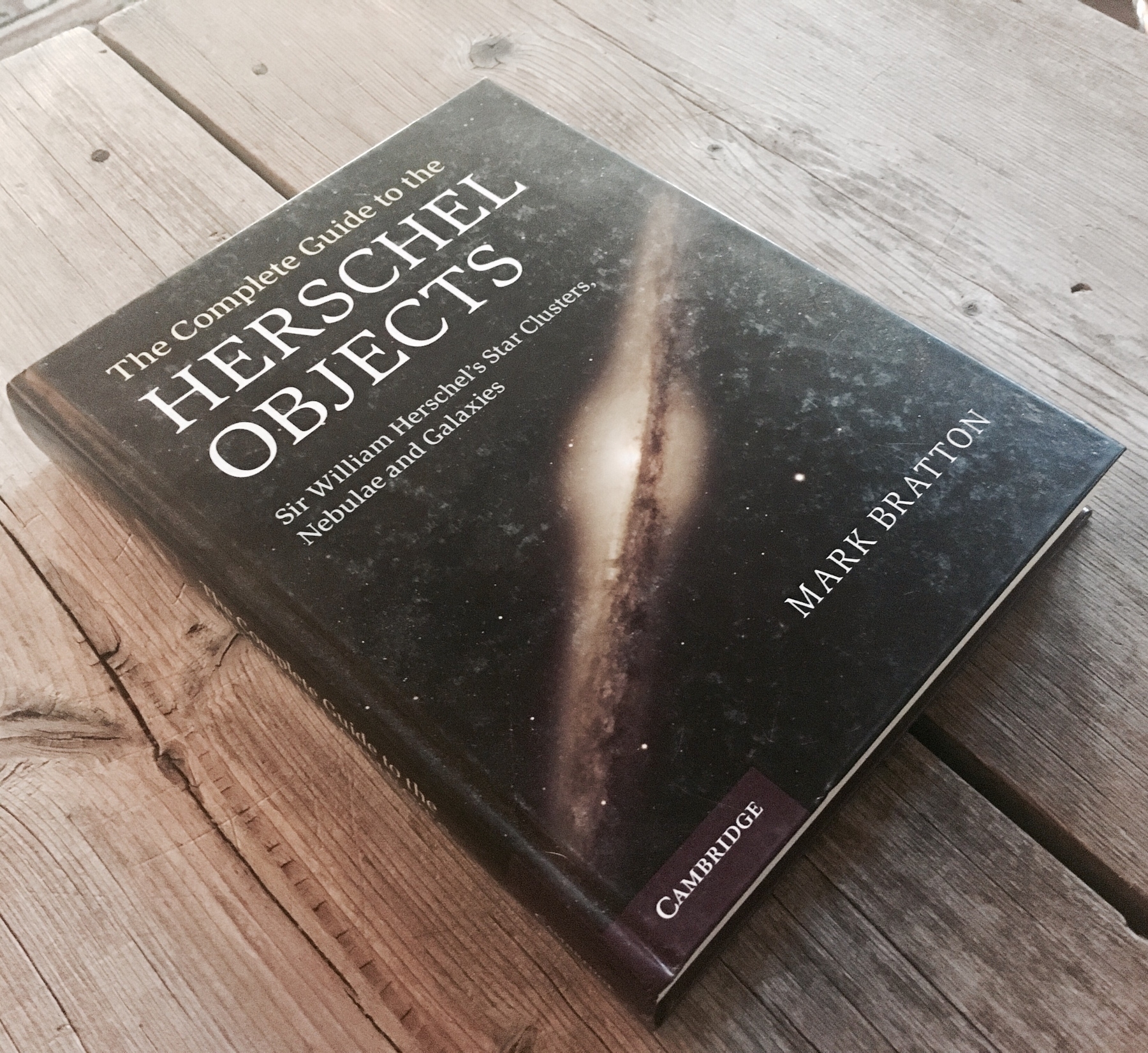
In the fall of 2012 I bought my first telescope since having one as a kid. I wasn’t sure how much use I’d get out of it but I wanted to give it a go. I suspected I’d not regret the purchase. Within the first couple of weeks I’d become obsessed. I went out each clear night and sometimes stayed up till I started dozing at the scope which was often in the wee hours of the morning. Within a couple weeks I’d started keeping track of the objects I was viewing. I started just with the date, object name/ID, date and time. Soon after I started noting the eyepiece I was using as well as a description. It occurred to me that it would be fun to do the full Messier list and get the certificate from the Astronomical League. Not that I cared all that much about the recognition but having a list helps give a bit of order to the process. Had I not taken it on I might have gotten stuck looking at the same objects. Another side effect of having a list and doing the “official” program is the requirement that the observer find the objects on their own. No go-to telescopes allowed. Which was not as much of an issue as I didn’t have a go-to telescope. But reading about the program drew my attention to the idea of systematic searching and recording.
A month into the Messier list I realized there were some nights that when I would have no objects to search for as I would have already found all the available objects on the list that were up in the sky. So it occurred to me to look for another list that I could start at which point I became aware of all the various programs that the Astronomical League administers. I settled on the Herschel I and got started. It’s a list of 400 objects from the NGC catalog of 7,840 objects, largely based on the observations of William Herschel, his son John and his sister Caroline. It’s a mix of galaxies, star clusters and various kinds of nebulae. It’s a great list to do after the Messier list because it is slightly more difficult with fainter objects.
I finished up, or thought I did, about a year later. Upon checking my list though I discovered that I’d bungled a few by not recording proper descriptions and I was also missing a few. So, I started filling in my gaps until, about a year later, I thought I was finished. And, again, I discovered a few I had missed! So, back to it. With each successive check my list of missed objects was getting smaller. Essentially my transition from the initial list to spreadsheet to database introduced a few errors. Over the past couple of months I’ve been taking care of the few remaining objects and in the wee hours of a late September morning I finally got the last object in my eyepiece. NGC 2372, a planetary nebula in Gemini. I entered it in to my report and spent the rest of the morning double checking my final list. All in all the list took about four years and during that time I recorded well over 500 observations for that particular list (many duplicates due to the first 100 or so having been recorded without the detailed descriptions).
What did I learn during the experience? I learned much more about seeing the objects. Early on I was moving too quickly from one object to the next. It was not uncommon for me to log 15 objects in a 4 or 5 hour session. That’s three to four an hour. When you consider the time it takes to find an object in the scope and record the observation it turns out I was only looking at some objects for 5 minutes or so. That’s a minimal amount of time. These days I tend to look at about half that number of objects and I spend more time on each one.
The process of really seeing a faint object requires dark adapted eyes (no bright lights after you start viewing. Only low levels of red light!) and it requires at least 10-15 minutes, often times more, for each object. I also find it helpful and more educational if I take some time reading about the object. I don’t necessarily see the object better but reading about it helps me appreciate what I’m seeing. It’s easy to do using Sky Safari which is my preferred astronomy app. Each object has a description associated with it, many of them are quite detailed. There are also images in the app which can be very helpful in finding some of the details that might otherwise be missed.
I also was also reminded that there is an important connection between observation, vocabulary and description. As with any skilled observation it is important to develop an understanding of the components of what is being viewed. For example, if I’m viewing birds I pay attention to not just the colors but also the shape of the beak and tail, the physical habits, the body shape, the song, etc. There are many details that will help me identify the species of bird I’m looking at as well as understand something about the bird for example it’s diet or food gathering habits. The same might be said of plants, trees, butterflies or any other observation of the natural world including astronomical objects. There is a certain literacy that goes with observation and increased literacy means a more detailed interpretation of the sensory data.
When I first began looking at galaxies I mostly just saw smudges of light. But right off it was evident that the shapes varied. For example, the Andromeda Galaxy (M31) and it’s two neighbor galaxies (M32, M110) vary quite a bit in size, shape, brightness and features. They’re a good starting point and learning tool. M31, a spiral galaxy, fills even the largest wide-field eyepiece with its large disc and offers a concentrated, bright nucleus as well as dust lanes. By comparison, M32, an elliptical galaxy, appears as a compact and bright nucleus with no disc. M110 is also an elliptical galaxy but is much larger than M32 and better described as an oblong nebulosity with a slightly bright central area but no bright core or nucleus. But while these three nearby galaxies are a good starting point and each offer different characteristics to be described they are just the beginning of many galaxies. Then there are the many kinds of nebulae and star clusters to learn about. No doubt astronomy offers many years of possible observation, a lifetime of possibilities in fact.
So, where to next? I’ve already started three other programs: double stars, nebulae, and the Herschel II list. I think I’m going to start the lunar program as well. As our closest neighbor the moon can cause a great deal of light pollution for much of each month making other observations difficult. But it’s a fascinating subject itself, why not enjoy it?!
Looking at other galaxies
One of the best things about living under really dark skies and having a decent telescope is viewing other galaxies. While I equally enjoy the many beautiful objects in our own galaxy such as nebulae and globular clusters, the hunt for distant galaxies has a meditative quality for me. Sometimes the finding is a bit of a let down. For example, last night I went looking for NGC 7042, a spiral galaxy. It took some doing but I found it. It’s 250 million light years away. Yeah. It was the faintest little smudge of light barely detectable on a very clear night with a decently sized telescope (12.5 inches). When I find these really faint ones I always laugh at my disappointment. Yes, it is a galaxy filled with billions of stars and yes, I just sighed in disappointment. But, but, it’s 250 million light years away I remind myself. Not only that it is moving away from us at 5,083 kilometers per second or, 1.7% the speed of light. There will come a time in the distant future when that galaxy and others are no longer visible from Earth. The stretched out light will no longer reach us. The Universe is expanding and that expansion is accelerating. Eventually galaxies that are currently visible to us will blink out. Of course, by that time we’ll likely not be here to notice.
The thing about viewing other galaxies is that it helps frame the scale of the Universe. When I look at the star Vega I’m seeing a star that is only 25 light years away. Yes, still a vast distance from our perspective. But it’s in our local neighborhood so to speak. In fact, it’s like a neighbor on our own street. Funny thing, the stars we see when we look up without a telescope are all in our local neighborhood. We’re only seeing about 6,000 of the very closest stars in our galaxy of 200 billion stars. When I look at the Orion Nebula I’m looking at something that is only 1,400 light years away. Sure, that’s a good bit further than Vega but again, remember that our Milky Way galaxy is an average of 100,000 light years in diameter. So, Orion is still very much in our local neighborhood.
[caption id=“attachment_928” align=“alignnone” width=“2560”] The Andromeda Galaxy is the largest galaxy of the Local Group which consists of about 45 other galaxies including our Milky Way.[/caption]
The Andromeda Galaxy is the largest galaxy of the Local Group which consists of about 45 other galaxies including our Milky Way.[/caption]
But back to the viewing of galaxies, the easiest to view from the Northern hemisphere of Earth is Andromeda which is “only” 2.5 million light years away. It fills the eyepiece of my telescope and can actually be seen with the naked eye if you’re under dark skies. I have no problem picking it out from the stars of the Milky Way. It’s oval of faint light is actually quite large and fills an area larger than the full moon in our night sky. It’s quite close and in fact, billions of years in the future we will in fact merge with Andromeda. I viewed Andromeda just two nights ago. I also viewed the Bode’s galaxy, M81 and the Cigar Galaxy, M82 which are a pair of galaxies 12 million light years away and are fairly bright and easy to find with a telescope. In 2014 a star went supernova in M82 and we were able to view it from Earth. Quite a show! So the pair is, in the larger scale of things, quite close. A bit further than Andromeda but not nearly as far as the 250 million light years that makes NGC 7042 so faint.
Faint and distant or bright and close, viewing other galaxies is a thrill because it means looking at the starlight of hundreds of billions stars. As those photons stream into my eyes I’ve got a direct connection with the ancient starlight created by billions of suns. It is light that has been stretching through the Cosmos for millions of years and ends its journey in my eye. The experience is one which enhances my perspective and gives life on Earth an added dimension. In seeing such distant worlds I begin to contemplate and understand the scale of the Universe in a way I had not before. It has changed who I am as a human as well as my understanding of what it means to be human.
When People Die
I’ve got an aunt who will likely be dying in the next couple of days. My mom’s sister. Death is an interesting thing because it’s the one fact that we all share, one of only a few certainties and yet, it is something so many resist. We create religions, in part, to help ourselves deal with our mortality. We create all sorts of elaborate beliefs to that end. My approach to death might be best summed up by one of my favorite songs, “Fact of Life” by Poi Dog Pondering:
“Relentlessly climbing and conquering and swallowing fresh painWe die and our bodies decay. The matter of our body, our molecules, are decomposed and released into the environment. Or, we may be cremated, the matter of our bodies released through a different process but still a process of transformation. Whatever the process, the atoms of our body are recycled. Frankly, I think it’s a fucking beautiful process and in fact, it’s happening during the course of life, every moment of every day. We shed our skin and other bodily cells all the time. We breathe in, absorbing the oxygen molecules released into the air by plants. We breathe out, releasing carbon dioxide which will be used by plants. A constant exchange, constant interaction We are of the Universe.
Melting reemerging and rising up clean in the pouring rain
Rise up clean in the pouring rain, only to drop down
and decay again
Muscle and sweat and blood and bones
feel good, feel strong!
Don’t ask why, it’s a fact you die”
And it’s not just our bodies that we shed. In a very real way our minds, our identities are also in flux. The Denny that writes these words is not the same Denny of 10 years ago or the Denny of 20 years ago. Each day brings now opportunity to grow and to change if we’re open to it. Even if we’re not, it’s going to happen. There’s nothing static about the Universe. It’s all movement, all the time. From the subatomic scale where the elementary particles of atoms of are in constant motion and interaction, to the atoms that make up molecules, to the tiny microbial life living on our skin to the planet and solar system. We can zoom out and out and out and still we find change, birth, decay.
Another Poi Dog song, Bury Me Deep:
“A lifetime of accomplishments of which the dirt knows none,Again, fucking fantastic. Yes. Yes.
Only in death can one truly return
Return the carrots, the apples and potatoes,
The chickens, the cows, the fish and tomatoes.
In one glorious swoop, let the deed be done
And bury me deep so that I can be one…
And all around my muscle and all around my bone,
Don’t incinerate me or seal me from
The dirt which bore me, the bed that which from
The rain falls upon and the fruit comes from
For the dirt is a blanket, no fiery tomb,
No punishment, reward, or pearly white room
And you who say that in death we will pay,
The dead they can’t hear a word that you say
Your words are not kind, sober or giving,
They only put fear in the hearts of the living
So put away your tongues and roll up your sleeves,
And pick up your shovel and bury me deep.”
And so, I think about my aunt and the other family members that have died in recent years, my grandfather, my granny, my other grandfather - and I smile. They all had long lives. Interesting lives. I’ve not shed a tear for any of them. Why would I? I think about my aunt who’s body is shutting down as I write. She will take her last breath very soon. Her body will grow cool. She will be gone. The consciousness that was hers will fade. Her family will remember her until they too die and fade away. I didn’t know it at the time but when I last saw her a month or so ago, that conversation was the last I will have had with her.
What can we do? We can go on. We can remember and we can do our best to live. I suppose, perhaps the best we can do for our dead is to relish and celebrate life with them before they die. And after they die go on celebrating life with the people they knew or with people they didn’t know. We all co-create this life together, we weave a rich tapestry that becomes vibrant and then weathers and fades and eventually disappears. These are our individual stories and fates just as one day all of humanity will fade. Even the stars transition from one state to another. Nothing in the Universe lasts for ever. Not planets or stars, not galaxies and the Universe itself may have some sort of end. We are in good company.
I think what I will do is celebrate. I will recognize that this pattern of energy known as Denny will not exist forever. I will try to use each day, to live each day in a way that recognizes that lifespan. I’m not sure where I heard it but there’s a quote that goes something like: “Live each day as if it were your first and each night as if it were your last.” Yeah. That.
A Sentient Being
Oliver Sacks on learning he has cancer
I cannot pretend I am without fear. But my predominant feeling is one of gratitude. I have loved and been loved; I have been given much and I have given something in return; I have read and traveled and thought and written. I have had an intercourse with the world, the special intercourse of writers and readers.
Above all, I have been a sentient being, a thinking animal, on this beautiful planet, and that in itself has been an enormous privilege and adventure.
Well said.
Cosmic Dance
A few weeks back I wrote about viewing the supernova in M82. It was first observed around the same time that an article was circulating about the continuing and drastic decline of Monarch butterfly populations. I had both the supernova and the threat to the Monarch on my mind when I sat down to write about my observation of M82 but I couldn't quite make the connection I wanted to make. A few days ago the Bad Astronomer, Phil Plait, in describing the earlier generations of star birth and death, comes close to articulating what it was I was pondering:
This happened in the Milky Way billions of years ago, and those elements from some long-dead star made their way into you. Your bones, your teeth, your blood, your very DNA have elements in them forged in the heart of a mighty star that violently tore itself to bits so that eventually you may live. It is a transformation on a literally cosmic scale.
I should hope the metaphorical metamorphosis is obvious enough. The only constant in the Universe is change, and much of it is a cycle. Birth, life, death, restructuring, and rebirth. That is also the theme of much of human art, from paintings and movies to myths and great novels.
Some say science is cold, dealing unemotionally with hard data. But that’s far from the reality. Humanity and life are reflected in the stars, and the Universe itself is poetry.
The thoughts I'd had were specific to the harsh reality of extinction on Earth. The Monarch is not there yet but it's numbers have declined drastically. Other species are also in decline and extinctions happen every day. In fact, according to the Center for Biological Diversity we are now experiencing the 6th mass exctinction event of the planet, loosing dozens of species a day:
It’s frightening but true: Our planet is now in the midst of its sixth mass extinction of plants and animals — the sixth wave of extinctions in the past half-billion years. We’re currently experiencing the worst spate of species die-offs since the loss of the dinosaurs 65 million years ago. Although extinction is a natural phenomenon, it occurs at a natural “background” rate of about one to five species per year. Scientists estimate we’re now losing species at 1,000 to 10,000 times the background rate, with literally dozens going extinct every day. It could be a scary future indeed, with as many as 30 to 50 percent of all species possibly heading toward extinction by mid-century .
Unlike past mass extinctions, caused by events like asteroid strikes, volcanic eruptions, and natural climate shifts, the current crisis is almost entirely caused by us — humans. In fact, 99 percent of currently threatened species are at risk from human activities, primarily those driving habitat loss, introduction of exotic species, and global warming. Because the rate of change in our biosphere is increasing, and because every species’ extinction potentially leads to the extinction of others bound to that species in a complex ecological web, numbers of extinctions are likely to snowball in the coming decades as ecosystems unravel.
For most of my adult life I've gone through a cycle of depression connected to or caused by my awareness of what we are doing to the planet and our fellow species. I will never accept what our species has done, is doing, to our planet but I have found a certain peace in the understanding that the Universe will go on regardless. Our fragile planet and the life on it has an end date. In 600 million years our sun will have have increased in luminosity significantly and the carbon cycle plants depend on will shift causing mass die-off of plant life and animal life. By the time the sun transitions from a main sequence star (4.5 bililon years from now) life on the planet will have long since disappeared. Such is the case for all life supporting planetary systems in the Universe. All stars have a limited lifespan.
The Monarchs will end. Humanity will end. Our planet, our solar system and our Sun will all have an end. So it goes. The cosmic dance will continue... for awhile anyway. What can we do but live our lives in the best possible way? I for one will try to live with a respect for the fragility of life on this Pale Blue Dot and with an understanding that the star stuff that makes up my body and this planet will one day be pushed forth into the Cosmos.
A Reassuring Fable
With the new Cosmos reboot coming, I present to you Part 3 of the Sagan Series.
Lunch with Carl
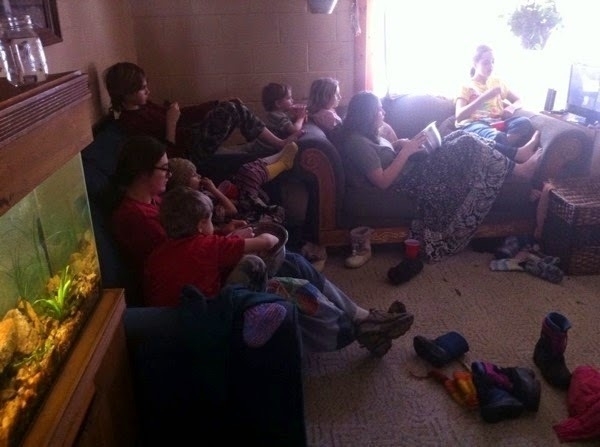 Lunch with Carl Sagan! Working our way through Cosmos in preparation for the new series with Neil DeGrasse Tyson.
Lunch with Carl Sagan! Working our way through Cosmos in preparation for the new series with Neil DeGrasse Tyson.
Weeping to the Cosmos

Moon photographed with iPhone and Z12, February 5, 2013
We had a fantastic night last night in our group observation for the Eastern Ozarks Astronomical Society. It was the usual crew plus a couple of newbies. Of course Russ and Karen were there. Kaleesha made it back for her third time at the scope and with her Blueberry and Seth. It was Seth’s first time and he took to the scope very naturally. Our new Farmington astronomer friend Mark made it for the second night in a row and though we were clouded out first night, last night we had perfect skies from sunset till sunrise. It’s always nice having new folks in attendance. We discussed open clusters, the use of the word nebula in the initial naming of galaxies which, at the time, were not known to be galaxies! We also went over star hopping with the 8" dobsonian with a red dot finder and folks got a chance to find a few Messier objects. Lots of fun! We also saw a very nice green fireball!
After most folks left Russ and I had an excellent conversation about the scientific method and the importance of skepticism. After that I took a brief dinner break and then set back out for some solo galaxy observations from my Herschel 400 list.
After about six galaxies I took a break to just look up with my eyes and the beauty of it was just too much. I suppose all there is to say about it is that I cried and I kept on crying. I thought I’d finished and then I cried more. No doubt, a part of what was going on was that I’d set a particular song on repeat, The Cinematic Orchestra’s song To Build a Home and I’m fairly certain that it was the song, combined with what I was seeing, that sent me over the edge. To be honest there have been several such moments during my nights at the scope over the past few months. I’m usually able to control it but sometimes it is good to just let go and accept it.
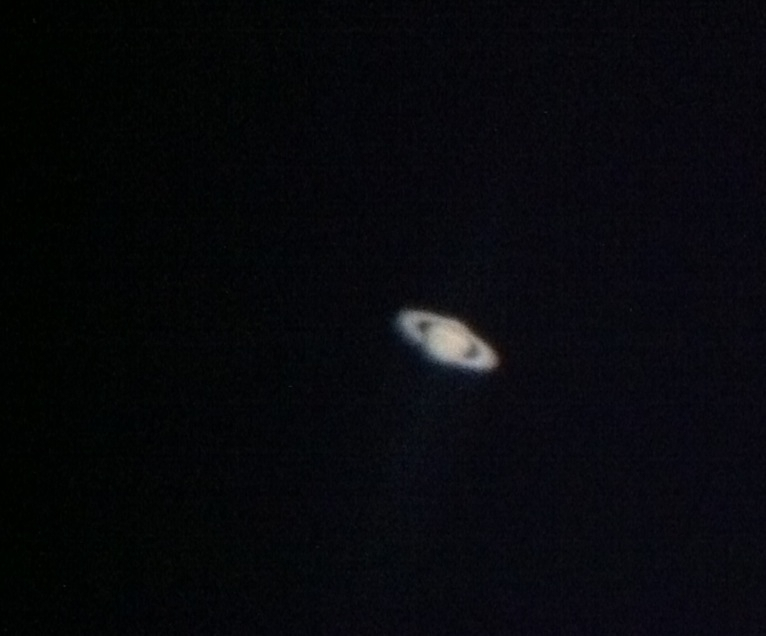 Saturn photographed with iPhone and Z12, February 5, 2013
Saturn photographed with iPhone and Z12, February 5, 2013
It’s not the first time I’ve had the sensation, a sort of heightened alertness and emotional intensity that just comes in like a slow motion wave. Usually it’s just the result of really being in the moment, be it under the night sky looking at stars or standing in the cold watching my breath seemingly frozen midair or any number of other similar moments. It is as if time slows down and in those moments I am not just seeing what’s around me, but being in what is around me. To put it simply, it seems like a convergence of emotion and intellect that results in something not quite our normal day-to-day experience, something overwhelming.
I’m guessing most people have these moments at various times in their lives… I certainly hope so. I’ve mentioned to a few folks recently that I feel like, more often than not, I exist in this sort of low level bliss. In part I think it comes with this kind of simple life. I own so little and live in such a small space that my life is not about owning but about being, about experiencing… searching and exploring. Our lives are short and so it makes sense to me to live it as my life but to do so in constant connection and ever deepening relation. I made a choice to never have children so being connected means something different for me. It’s frogs and stars, geese and planets, friends and family, it is belonging to life and to the earth and to this cosmos. When you belong you are free.
